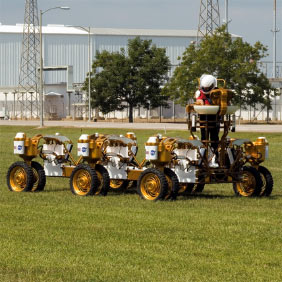NASA's Chariot: Not Your Father's Lunar Rover

The NASAChariot is a lunar truck prototype created to service the future US lunar outpost. Developed by the Exploration Technology Development Program'sHuman-Robotics Systems Project in just eleven months, the vehicle is designedto meet the payload transport, range, terrain and speed specifications definedby NASA?s Lunar Architecture Team.
The Chariot's chassis can be reconfigured for a variety ofpurposes and payloads. It can carry a mix of suited crew and payload; it canalso be outfitted with a small pressurized cabin.
The pilot's control pedestal can rotate 360 degrees; theChariot has no "front" or "rear." According to Johnson Space Center roboticist Rob Ambrose "The Apollo astronauts couldn't back up atall because they couldn't see where they were going in reverse." Thevehicle itself has a zero turn radius — it can turn around entirely within itsown length (see video).
NASA's Chariot is also the first lunardrop deck lowboy — the Chariot can drop the chassis right down to theground for easy loading and unloading.
Get the Space.com Newsletter
Breaking space news, the latest updates on rocket launches, skywatching events and more!
The specifications for Chariot were set forth as follows:
Chariot Spec | Earth Prototype | Lunar System |
Payload | 1000 kg | 3000-6000 kg |
Vehicle Mass | 2000 kg | 1000 kg |
Top Speed | 20 kph | 20 kph |
Range | 25 km | 100 km |
Slope Climbing | 15 Degrees | 25 Degrees |
Science fiction writers have spent a fair amount of timethinking about how to get around on the Moon's surface. Arthur C. Clarkethought we might need mass transit:
"The monocab entered a long tunnel at the base of oneof the domes. Sadler had a glimpse of great doors closing behind them — thenanother set, then another. Then there was the unmistakable sound of air surgingaround them, a final door opened ahead ..."
(Read more about Clarke's monocab from Earthlight[1955])
Clarke also created a practical vehicle for towing materialaround on the Moon's surface that took advantage of the powdery lunar soil -the dust-ski, which moved like a jet-ski through deep lunar powder:
"At that very moment ... one of the searching dust-skiswas passing directly overhead. Built for speed, efficiency and cheapness ... Itwas, in fact, no more than an open sledge with seats for the pilot and onepassenger — each wearing a space suit — and with a canopy overhead to giveprotection from the sun. A simple control panel, motor and twin fans at therear, storage racks for tools and equipment — that completed the inventory. Aski going about its normal work usually towed at least one carrier sledgebehind it ... "
(Read more about Clarke's dust-ski from AFall of Moondust [1961])
Robert Heinlein thought that lunar prospectors might want tohave something more personal for travel and hauling:
"The solitary prospector, deprived of his traditionalburro, found the bicycle an acceptable and reliable, if somewhat lesscongenial, substitute. A miner's bike would have looked odd in the streets ofStockholm; over-sized wheels, doughnut sand tires, towing yoke and trailer,battery trickle charger, two-way radio, saddle bags and Geiger-counter mountmade it not the vehicle for a spin in the park — but on Mars or on the Moon itfitted its purpose the way a canoe fits a Canadian stream. "
(Read more about Heinlein's lunocycle from TheRolling Stones [1952])
From NASAChariot via Wired.
(This Science Fiction in the News story used withpermission of Technovelgy.com— where science meets fiction)
- VIDEO:Robo-Athlete for the Moon
- RecyclingCenter Needed On the Moon
- All About the Moon
Join our Space Forums to keep talking space on the latest missions, night sky and more! And if you have a news tip, correction or comment, let us know at: community@space.com.
Bill Christensen is the founder and editor of Technovelgy, a website dedicated to cataloguing the inventions, technology and ideas of science fiction writers. Bill is a dedicated reader of science fiction with a passion about science and the history of ideas. For 10 years, he worked as writer creating technical documentation for large companies such as Ford, Unisys and Northern Telecom and currently works to found and maintain large websites. You can see Bill's latest project on Twitter.









